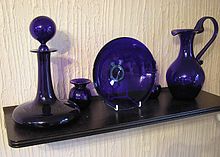| Smalt | |
|---|---|
| Hex triplet | #003399 |
| sRGBB (r, g, b) | (0, 51, 153) |
| HSV (h, s, v) | (220°, 100%, 60%) |
| CIELChuv (L, C, h) | (26, 74, 261°) |
| Source | ColorHexa[1] |
| B: Normalized to [0–255] (byte) | |

Cobalt glass—known as "smalt" when ground as a pigment—is a deep blue coloured glass prepared by including a cobalt compound, typically cobalt oxide or cobalt carbonate, in a glass melt. Cobalt is a very intense colouring agent and very little is required to show a noticeable amount of colour.
Cobalt glass plates are used as an optical filter in flame tests to filter out the undesired strong yellow light emitted by traces of sodium, and expand the ability to see violet and blue hues,[2] similar to didymium glass. However, didymium glasses are superior for this purpose as it absorbs less light other than the Sodium D lines.[3] Specialty tasting glasses made of cobalt glass are used by professional olive oil tasters to disguise the color of the oil being assessed to avoid bias in judging. [4]

Moderately ground cobalt glass (potassium cobalt silicate)—called "smalt"—has been historically important as a pigment in glassmaking, painting, pottery, for surface decoration of other types of glass and ceramics, and other media.[5][6] The long history of its manufacture and use has been described comprehensively.[7] Cobalt aluminate, also known as "cobalt blue",[8] can be used in a similar way.
Cobalt glass such as Bristol blue glass is appreciated for its attractive colour and is popular with collectors. It is used in the distinctive blue bottles of Harvey's Bristol Cream sherry and Tŷ Nant mineral water.

- ^ "Smalt / #003399 hex color (#039)". ColorHexa. Retrieved 2022-12-22.
- ^ Glass Plates, Cobalt, Flinn Scientific
- ^ Hahn, Richard B. (November 1950). "Flame tests in the presence of sodium". Journal of Chemical Education. 27 (11): 597. doi:10.1021/ed027p597. ISSN 0021-9584.
- ^ [1], Olive Oil Times
- ^ "The Changing Properties of Smalt Over Time". Tate. Retrieved December 26, 2020.
- ^ Weyl, W.E. "Coloured Glasses". Society of Glass Technology, 1999, p. 179, ISBN 0-900682-06-X
- ^ Seccaroni, Claudio; Haldi, Jean-Pierre (2016). Cobalto, zaffera, smalto dall'antichità al XVIII secolo (in Italian). ENEA. ISBN 9788882863418.
- ^ "Cobalt". Encyclopædia Iranica. Retrieved December 26, 2020.
